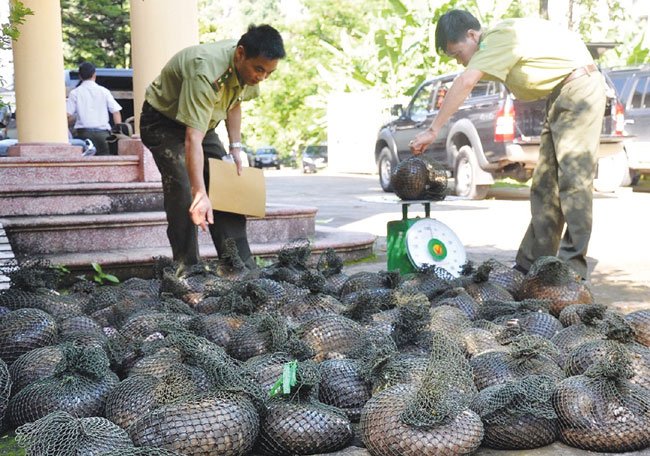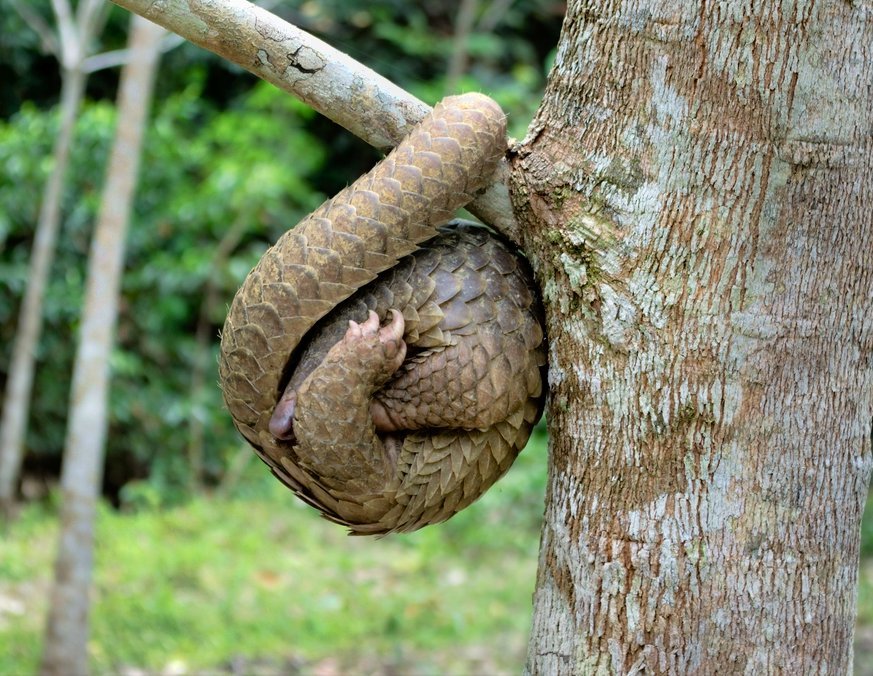What is scaly from tip to toe and can curl up into a ball? Only the worlds most trafficked animal, the Pangolin.

Source
There are 8 species of Pangolin found in two continents, four within Africa (Black-bellied, White-bellied, Giant Ground and Temminck’s Ground) and four in Asia (Indian, Philippine, Sunda & Chinese). All of these species are classed at least Vulnerable on the IUCN Red List with two of the species, the Sunda and Chinese classed as Critically Endangered.
Scientists are still unsure of what their closest relatives are, it was widely believed they were from the Xenarthra family which includes Anteaters and Armadillos, after all they do resemble these animals in a number of ways, new research however has led to the idea they may share a closer relationship to Carnivora, a family that includes Bears and Wolves.

Source
Pangolins are the only scaled Mammal in the Animal Kingdom, a trait most commonly observed in Reptile and Fish species. These scales are made of Keratin and make up 15% of the Pangolins overall weight. It has a small head, long broad tail, no external ears (yet its hearing is good), and no teeth, instead relying on a gizzard-like stomach that has adapted small Keratin spines to grind up their food. To assist with the grinding of its food, the Pangolin will consume small stones and sand in the same way that most Avian species do.

Source
Hiding in their burrows during the day and coming out at night to hunt, they have some of the smallest eyes in comparison to their overall size of all mammal species, this trait results in very poor eyesight with very little value for hunting, they instead use their fantastic sense of smell to locate Termite mounds and Ant nests, digging into the mounds using its tough claws and eating the Insects with its long tongue (measuring up to 16 inches). To enable it to grab its food, they have large salivary glands that coat the tongue with mucus that the ants and termites stick to. The long-tailed Pangolin is the only Pangolin that isn’t nocturnal, it also has the best eyesight of all 8 species, as the others are nocturnal they instead have an amazing sense of smell to locate insects in the darkness.

Source
Pangolins behave just like hedgehogs by rolling themselves up into a tight ball as self-defence. Pangolins cover their head with their front legs to dissuade any predators, if the predator persists the Pangolin will roll into an impenetrable ball, the scales on its tail are sharp and can be used as a defensive weapon by lashing out.

Source
At birth, a young Pangolin is 6 inches long and weighs just 12 ounces, they are pale and their scales are soft, not fully hardening until approximately 48 hours after birth. At 1 month old, they begin to eat termites, as they are mammals they are also nursed on their mother’s Milk up to 4 months of age. The infant will accompany its mother on hunts riding at the base of her tail, if the mother senses danger the infant will slip under to her stomach so she can roll up and protect both herself and her infant.

Source
Human threats to the Pangolin
The Pangolin is the worlds most trafficked mammal with an estimated 100,000 of these creatures taken from the wild each year. They are hunted for their meat and scales which is in high demand in Asian countries, the meat is a delicacy whereas the scales, which are the same material as Rhinoceros horn, are used in traditional Chinese medicines. In September 2016, the Convention on International Trade in Endangered Species of Wild Fauna and Flora (CITES) banned all commercial trade worldwide to protect all Pangolin species. It is thought that their population has dropped by as much as 90% in some areas, this opinion is based on testimony of local people who used to hunt the Pangolin in the preceding decades. Between 2011-2013, an estimated 116,990-233,980 Pangolins were killed based on reported seizures. It is believed that the seizures only represented 10% of the actual volume in which the Pangolin was illegally traded.

Source
More Amazing facts
- They are one of the few species in the Animal Kingdom that can have a tongue longer than the length of its body, their tongue starts in their chest cavity and can be over 40 centimetres long.
- A pangolins name is purely observational and comes from the Malay word “Pengulling” which means rolling up.
- Their defence mechanism is so successful that even apex predators such as lions, are unable to penetrate through their scales

Source
- It’s main method of defence also makes it easier for humans to capture them, their evolutionary defence is sadly their modern weakness.
- They can adapt to the terrain they are in, with some Pangolins living in underground burrows whereas others are able to live semi-arboreal lives in trees.
- The oldest Pangolin in captivity survived to 19 years of age, the vast majority of attempts to house Pangolins in captivity has resulted in premature deaths, no one has any real idea how long they can live for in the wild as they often lead elusive lives, partner that with persecution and the likelihood of a Pangolin living to an old age in the wild is slim.
- Species such as the Long-tailed Pangolin, have a prehensile tail that helps them climb trees and hang from branches.

Source
Amavi’s Amazing Animals Poo Fact
They need to tell their mates where they are with their poo

Source
They share a trait similar to skunks in that they can produce a noxious liquid from glands near their Anus, however they cannot spray it like their furry counterparts. They use their poop to not only mark their territory but to also inform a mate of their whereabouts, as elusive and solitary animals this is their only method of communication.
It’s a mammal, but looks like a reptile, yet has a digestive system designed for a bird and is one of the most Amazing animals on this planet.

Want more Amazing Animals? Check out
The Giraffe
The Emperor Penguin

